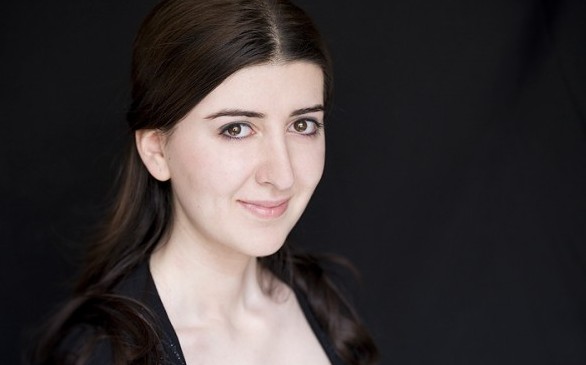
P ianist Nareh Arghamanyan delivered a romantic tour de force last night, in her performance in the Friends of Chamber Music’s Master Pianists series.
- Mendelssohn: Variations Sérieuse, Op. 54
- Beethoven: Piano Sonata No. 31 in A-flat Major, Op. 110
- Chopin: Polanise-Fantaisie in A-flat Major, Op. 61
- Schumann: Humoreske in B-flat Major, Op. 20
S lavoj Žižek writes about ‘missing melodies’ in Schumann’s Humoreske in The Parallax View (pp. 365-6) and perceives some of the same peculiarities of this piece that Arghamanyan devotes extra attention to...
I think more about her playing... It strikes me that Arghamanyan’s romanticism is like Japanese Nogaku music. The non-Euclidean, non-deterministic aspects: free-rhythm, but freedom that is studied, controlled... Metric inexactitude that is curiously exact in its inexactness; rubato, dilation of the meter—all of these are required, in service of the thing she wants to express. Nagauta, uki-ma: slightly lengthening early beats in a phrase; tsume-ma: slightly shortening early beats. Akuma no ma: “The Devil’s Meter”.
T he Humoreske’s capricious changes of mood, the loose concatenation of the disparate sections of the piece—not movements exactly; their beginnings and endings are not meant to be clear, and this decoupled, spontaneous, narrative feeling is something that Arghamanyan achieves beautifully. There’s nominally the opposition of the meditative character of Schumann/Eusebius with the extroverted moods of Florestan, inner voices in the score, the voice of Clara and her G minor Romance. The music moves impulsively forward with dramatic excitement, a short pause followed by emphatic chords that give way submissively to the final section and dramatic outbursts.
B ut Arghamanyan’s rhythmic choices made Schumann and Chopin seem especially—and very plausibly—‘interior’, ‘sensitive’. The romantic ‘decoupling’ (steady LH, free RH) is an effect that she never over-uses.
T he Mendelssohn and the Bach BWV 974 encore revealed Arghamanyan’s [shōmyō-like] rhythmic/metric style even more strikingly. Her shifts of tempo, tone color, and articulation are blended into a subtly modulated flow—modulated not only by the personality of the music, but also by the empathetic personality of this Hamburg Steinway and its lively double-crowned soundboard. Her performance style is so ‘about the music’ and so not about herself. (By the way, I hope this is an instrument that FCM decides to acquire. It is one of several that have been provided by Steinway & Sons on approval. I think last night’s performance was the first concert where this wonderful instrument has been heard in the Folly Theater.)
I n sum, gorgeous playing by Arghamanyan throughout... insightful interpretations that enabled us to see and appreciate new things, things we never noticed before, things we’d never have discovered without her help.
- Nareh Arghamanyan website
- Nogaku Japanese Traditional Music. (World Music Library, 1994.)
- Arias E. Comedy in Music. Greenwood, 2000.
- Daverio J. Robert Schumann: Herald of a 'New Poetic Age'. Oxford Univ, 1997.
- Hudson R. Stolen Time: The History of Tempo Rubato. Clarendon, 1997.
- Jensen E. Schumann. Oxford Univ, 2001.
- Jo K. Gagaku and Serialism. Routledge, 1998.
- Krebs H. Fantasy Pieces: Metrical Dissonance in the Music of Robert Schumann. Oxford Univ, 1999.
- Malm W. Traditional Japanese Music and Musical Instruments. Kodansha, 2001.
- Patterson A. Schumann. BiblioBazaar, 2008.
- Perrey B, ed. Cambridge Companion to Schumann. Cambridge Univ, 2007.
- Perrey B. Schumann's Dichterliebe and Early Romantic Poetics: Fragmentation of Desire. Cambridge Univ, 2003.
- Sheppard W. Revealing Masks: Exotic Influences and Ritualized Performance in Modernist Music Theater. Univ California, 2001.
- Tokita A, Hughes D. The Ashgate Research Companion to Japanese Music. Ashgate, 2008.
- Tunbridge L. Schumann's Late Style. Cambridge Univ, 2007.
- Žižek S. Parallax View. MIT, 2009.
S chumann’s ‘Humoreske’ was among the first to demonstrate that purely instrumental music can be humorous.”
— Enrique Arias, Comedy in Music.
No comments:
Post a Comment